Elsa Schiaparelli
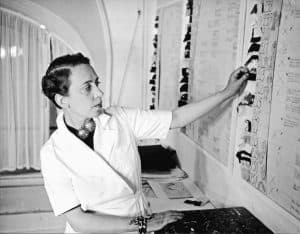
The House of Schiaparelli founded by Elsa Schiaparelli in her apartment in Paris came a long way with ‘ahead of its time’ designs and constant evolution. Various artistic influence made the House even more delectable. The House of Schiaparelli to this day stands as the perfect example of ‘wearable art’.
Index
The Origin
Brand Development
Brand Revival
Schiaparelli Style
Iconic Pieces & Collaborations
Exhibitions
Current Situation
The Origin
Schiaparelli was born Elsa Luisa Maria Schiaparelli at the Palazzo Corsini, Rome in the year 1890. She grew up in a family of aristocrats. Her father was the director of the Lincei Library in Rome and a professor of Oriental literature. Her mother was a descendant of the Medicis. Her uncle Giovanni Schiaparelli was a famous Italian astronomer.
She studied philosophy at the University of Rome, where her father had also served as Dean.
Elsa has always been a rebel. In the year 1911, she published a collection of overtly sensual poems, Arethusa. This resulted in her parents sending her off to a convent in Switzerland. But she left the place after a hunger strike.
Marking the year of her emancipation, in 1913 she set off for London. And this is where she met her future husband Count Wilhelm Wendt de Kerlor a theosophist, when attending a conference on theology.
They married in 1914 and left for New York in 1916. Elsa formed a friendship with Gabrielle Picabia, first wife of Dada painter Francis Picabia on the liner taking them to New York. This encounter later introduced Elsa to the circle of avant-garde artists of the time.
After Elsa’s divorce, she moved to Paris with her daughter in 1922. The move was made to seek better treatment for her ailing daughter. During the day Elsa worked at an antique dealer’s and in the evening, she frequented the famous restaurant, Le Boeuf sur le Toit. This is where her circle of artist friends grew. It was this year that she developed a friendship with the greatest couturier of the age, Paul Poiret whose influence proved to be one of the turning points in her life.
In the mid-1920s it was this influence that led her to become a freelance designer. Her first famous creation came around this time, which was a hand-knit pullover with a black and white trompe-l’oeil (a technique that uses realistic imagery to create an optical illusion that the depicted object seems three dimensional) motif. This soon was deemed a ‘masterpiece’ by Vogue and it became a star product within a few months in the United States.
Elsa founded her company in her own apartment, in the year 1927.
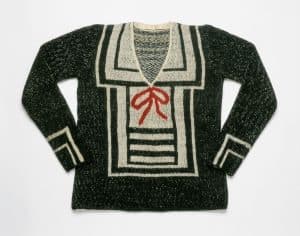

Brand Development
The year that marked the official presence of the brand was 1928, as it was this year that Schiaparelli set up ateliers, salons and offices at 4, rue de la Paix with “Schiaparelli-Pour le Sport” (Schiaparelli-Sportswear) on the door plate.
Schiaparelli-Sportswear collection included not only knitwear pieces but also swimsuits, beach pyjamas and accessories. The motifs became more varied with abstract tortoises, skeletons, sailor tattoos etc.
This year Schiaparelli also launched her first fragrance, “S”.
From the year 1929 onwards, the brand introduced a growing number of innovations in terms of materials, cuts, details and accessories. Some major innovations included, a raincoat in rubberized wool and silk, jumpsuits and visible zips, the first evening dress (a wrap dress with a plunging neckline), culottes, strong-shouldered suits (the predecessor of the power suit), reversible black and white evening dresses, aerodynamic cuts, eccentric hats (like the Mad Cap which became beyond famous) and the metal mesh bag.
The Couture House, which had become “Schiaparelli-Pour le Sport, Pour la Ville, Pour le Soir” (Schiaparelli-Sportswear, City and Evening Wear) in the year 1932, spanned several floors and included eight ateliers accommodating over 400 employees.
Schiaparelli opened a store and salons in London and an office in New York in the year 1933.
The House presented a collection of three perfumes in 1934- Soucis, Salut and Schiap. And it was this year that Elsa Schiaparelli became the first female fashion designer to be featured on the cover of the American magazine, ‘Time’.
The Couture House took over the Hotel de Fontpertuis at 21 place Vendôme in 1935 with five floors, 98 rooms, over 700 employees and a ground-floor boutique. This year marked the creation of the first coat-shirt, taking inspiration from the male-wardrobe.
The House’s most famous collaborations came in the 1930s. With Salvador Dali, she created now-legendary pieces like, suits with bureau-drawer pockets, shoe-hat, lobster-printed dress, skeleton dress, the tear dress, Le Roy soliel perfume bottle etc. and Jean Cocteau’s drawings featured on coats, evening ensembles and jewelry.
The launch of the perfume ‘Shocking’ and the colour “shocking pink” took place in the year 1937. The perfume, whose bottle was designed by Léonor Fini represented a dressmaker dummy following the curves of Mae West, decorated with porcelain flowers and a velvet measuring tape became an unprecedented success. It was this year that Schiaparelli invented “shocking pink”, a pure, vibrant, undiluted, intense and lively pigment.
Amid the Couture House’s immense success, struck the Second World War. Until the summer of 1940, it was getting too hard to keep the business running and to maintain the jobs. But it was in this year that the House launched a perfume, ‘Sleeping’ to recuperate. In view of air raids, the House also created practical and comfortable clothing like zippered jumpsuits with maxi pockets intended to hold the equivalent of a handbag, coats with integrated bag, transformable dresses etc. It was this year, that Elsa became the first European to receive the Neiman Marcus award for services to fashion in Dallas.
The Couture House was handled by Elsa’s right-hand man from May 1941 to July 1945, as it was getting dangerous for her to stay in Paris being an Italian.
After France was liberated, Schiaparelli returned, immediately taking over the House. The collection was presented as early as September 1945. It was around this time; Hubert de Givenchy was hired as the creative director of the Schiaparelli boutique.
The following years, the House launched perfumes, Roy Soleil, Zut and Succès Fou. A perfume factory was also built in the suburbs of Paris to keep up with the old and new productions.
Keeping up with the post-war time new woman, who was now accustomed to travel more, in 1946 Schiaparelli House created ‘the Constellation’ wardrobe. The collection consisted of six dresses, one reversible coat and three folding hats. All of the garments were under 12 lbs (i.e. under 5 kilograms).
Despite the strike of part of Schiaparelli’s Haute-Couture ateliers, Elsa presented the collection in August 1949. The collection was unfinished and one can still see pins, fabric swatches and no buttonholes. However, it took the industry by storm. The youthful style and the evening dress with the visible bra led the media houses like, New York Times to describe the collection as ‘Striking’. Newsweek devoted its front page to Elsa.
Despite the Couture House’s successes and good sales, Elsa soon realized that post-war sense of fashion and that of Haute Couture in particular has changed. She then decided to close her Couture House in the year 1954.
Elsa then devoted her life to her autobiography ‘Shocking Life’. She died in the year 1973 at the age of 83.
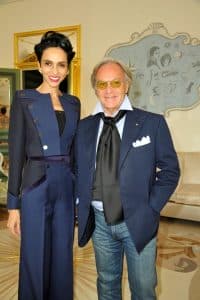
Brand Revival
The Tod’s Group Chairman Diego Della Valle acquired the rights of Schiaparelli’s archives in the year 2006.
Diego Della Valle set to relaunch label Schiaparelli in 2012 with product unveiling. With focus on accessories, fragrance, cosmetics and clothing. Farida Khelfa was named the spokeswoman for the label.
French Couturier Christian Lacroix was invited to Schiaparelli in July 2013 to produce a one-off fifteen-piece couture collection for Schiaparelli Fall Couture 2013. It was a homage collection by the designer for a theatrical relaunch of the House. The collection was unveiled at the legendary salon on the Place Vendôme.
Marco Zanini was named the creative director of the Couture House in September 2013, having spent five years as the creative director of Rochas. Unfortunately, thirteen months later he parted ways with the House.
Marco Zanini presented the House’s first collection in January 2014 after a gap of 60 years for S/S 2014. Zanini called upon the likes of Stella Tennant and Jessica Stam to make the event more ravishing and dramatic. The collection was made to stay true to its roots. The gowns were inspired from the thirties, with vibrant colours and specks of surrealism and wildness, along with playful accessories to capture Schiaparelli’s bold and eccentric sense of style.
Zanini presented his final collection for the House in July for Autumn/Winter 2014 couture. This collection was highly praised with eye-catchy elements and exaggerated silhouettes.
The S/S 2015 couture collection for Schiaparelli was designed by the in-house team following the departure of Marco Zanini. The show concept on the other hand was designed by Jean-Paul Goude, a French graphic designer, illustrator, photographer and advertising guru. The show included a cappella-choir singing from windows above. The collection drew inspiration from Schiaparelli’s style with flowing trouser suits, big shoulders and used surrealist prints such as Salvador Dali’s molten framed mirrors.
Schiaparelli named Bertrand Guyon as the new creative director in April 2015.
Guyon presented his first collection for Schiaparelli in July 2015 for the season Autumn/Winter 2015 couture. The collection used a lot of colours, embellishments and textures. It displayed exquisite embroidery and brocade including elements like padded shoulders, sleeveless capes and tweeds and tartans.
Guyon presented the S/S 2016 couture collection in January 2016. This collection was one of its kind. Taking inspiration from Elsa’s autobiography, where she writes, “Eating is not merely a material pleasure. Eating well gives a spectacular joy of life and contributes immensely to goodwill and happy companionship. It is of great importance to the morale”. Guyon created a collection based on this sentiment and reimagined Dali’s lobster dress along with other inclusions.
In February of 2016, Bertrand Guyon presented the Schiaparelli’s new collection of “prêt-à-couture”. And as suggested by its name, the collection was a mix of both couture and ready-to-wear. The collection was presented at company’s Place Vendôme.
Director Bertrand Guyon presented Spring 2017 Haute Couture collection in January 2017. The collection took inspiration from the House’s founder Elsa as well as Guy Bourdin, the famous French photographer known for his provocative work. This collection made the best use of the House’s iconic symbols like the ornate lock or the lobster with simple silhouettes.
Guyon presented Spring 2018 couture for Schiaparelli in January of this year. The collection celebrates the relationship between reality and fantasy. The collection also took inspiration from Schiaparelli’s Pagan Collection of 1938, hence including embroidered insects, trimmed feathers, embellished safari jackets and ethereal gowns.
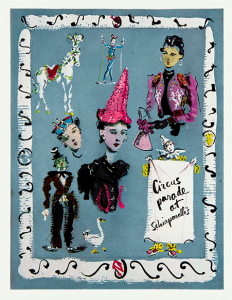
Schiaparelli Style
Each of Schiaparelli’s collections told a rich story, borrowing from the precious and the ordinary, art and everyday life, the figurative and the narrative, surrealism and referenced symbols, the poetic and the architectural, black and the most striking colours, the provocative and the severe. Elsa handled paradox and complementarity with ease.
Schiaparelli was the first to give her collections a theme like the “typhoon” look, the “parachute” look, “Stop, Look & Listen”, “Le Cirque” (circus), “Commedia dell’Arte” (art comedy), “Païenne” (pagan), “Astrologie”, etc. denoting that it was important for her to tell a story no matter how simple or complex.
Schiaparelli was truly ahead of her times (she was the first to launch a line of designer sunglasses). Her style reflected themes that are questioned to this day. She was also the first woman to have mastered the genre of ‘wearable art’ and brought surrealist elements to all of her collections. The name Elsa Schiaparelli became synonymous to ‘shocking’, a word she owned.


Iconic Pieces & Collaborations
1927: The first garment of Schiaparelli’s to get global recognition was the hand-knit pullover with trompe-l’oeil motif.
1931: Schiaparelli dress with trompe-l’oeil painted pleats created with her first collaboration with an artist- Jean Dunand.
1932: Creation of ‘madcap’. This tiny hat was knitted and looked like a tube, taking whatever shape the wearer wants.
1935: Hands painted by Pablo Picasso to resemble gloves inspired Schiaparelli to create her famous black gloves with nails in red python.
1936: Schiaparelli bureau-drawer suit was the result of the first collaboration between Schiaparelli and Dali.
1937: Schiaparelli dress with lobster print is created by Salvador Dali. The dress was immortalised by Wallis Simpson. Schiaparelli coat embroidered with trompe-l’oeil faces with shocking pink roses using Jean Cocteau’s drawing is another icon piece from this year. The ‘shoe hat’ was created this year by Schiaparelli and Dali for Schiaparelli Winter 1937-1938 Haute Couture collection.
1938: Creation of the ‘tear dress’ by Schiaparelli-Dali collaboration. It is an evening dress printed with a trompe-l’oeil motif creating an illusion of strips of flesh, accentuated by fabric appliqué. The ‘skeleton dress’ was created by this collaboration as well. The evening-dress created an effect of trompe-l’oeil of three-dimensional bones using padded ridges on the rayon crepe.
1951: Schiaparelli’s pleated evening gown created in Summer 1951 for the Haute Couture collection created luxurious graphic effects and was photographed for Vogue by Horst P. Horst.
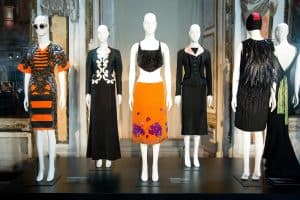
Exhibitions
Schiaparelli’s works have found a place in many illustrious museums all over the world. “Shocking” The Art and Fashion of Elsa Schiaparelli was in exhibit at Philadelphia Museum of Art from September 2003-January 2004 and at Museé de la Mode in Paris from March-August 2004.
Schiaparelli and Prada: Impossible Conversations was exhibited at, The Costume Institute of The Metropolitan Museum of Art, New York from May-August 2012.
Couturier Christian Lacroix’s tribute collection to Schiaparelli was exhibited at the Musee des Arts Decoratifs, Paris in 2013.
Schiaparelli’s black evening gown with white printed butterfly applique designed for the Summer of 1937 is on display at Palais Galliera, Musée de la Mode, Paris as part of their ‘Fashion of the first half of the 20th-Century collection. The gown was a gift by Maison Schiaparelli.
Schiaparelli’s dark red velvet gown with extensive embroidery created in 1937, is on display at MUDE Museo do Design e da Moda, Lisbon.
Schiaparelli’s 1938 creation, a cape embroidered by Lesage is part of Les Arts Décoratifs in Paris.
One of Schiaparelli’s printed silk dress (1946) is on display at Galleria del Costume di Palazzo Pitti, Florence.
Some of Schiaparelli’s celebrated pieces were displayed at Platt Hall Gallery of Costume, Manchester as part of the collection Schiaparelli and Thirties Fashion from January 2016-October 2016.
Dali & Schiaparelli was presented in collaboration by the Dali Museum and Schiaparelli Paris from October 2017-January 2018 in St. Petersburg, US.
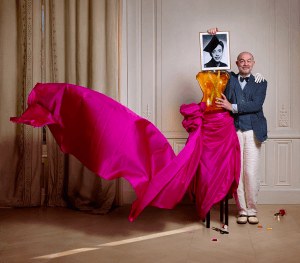

Current Situation
Since 2015, Bertrand Guyon is the appointed design director of Schiaparelli Haute Couture and Prêt-à-Couture collections.
Schiaparelli Salons-Boutique opened to the public in 2016 within the Couture House at 21 place Vendôme.
Schiaparelli was awarded with the official Haute Couture label in 2017 by the French Ministry of Industry and the French Couture Federation.
At the 32nd Hyères International Fashion and Photography Festival 2017, Schiaparelli was invited to present an exhibition at the Villa Noailles’ while Bertrand Guyon was made the president of the fashion jury.
The 71st Cannes Film Festival 2018, saw a series of Schiaparelli creations on the carpet. The likes of Virginie Efira (French actress), Sara Sálamo (Spanish actress), and model Kendall Jenner all donned Schiaparelli Haute Couture.

